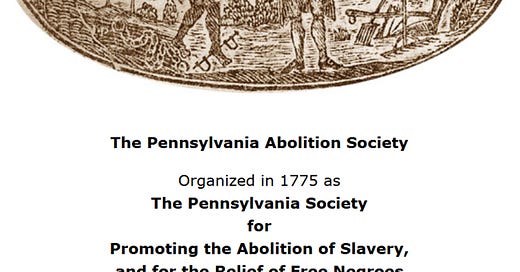The drumbeat of Revolution was becoming increasingly impossible to ignore in the spring of 1775. Olive branches had been extended and ignored – from both sides of the controversy. Violence was never far away, as anti-British sentiments clashed with calls for patriotism and loyalty to Britain as the Mother Country across the colonies.
We know now that war was imminent. The “Shot Heard Round the World” at Lexington and Concord was only a few days away (I’ll write about it next week). We also know that the revolution achieved independence but did not broadly alter the social or political hierarchies in the former British colonies after independence. In many of the former colonies, the same families dominated the political scene after the revolution as had dominated before—the Pinckney family in South Carolina and the First Families of Virginia in Virginia, for example.
But April 14, 1775, also marks the onset of structured opposition to chattel slavery – the institution that would undermine the democratic claims of the new American Republic until the present day. Known as the Society for the Relief of Free Negroes Unlawfully Held in Bondage, a new organization in Philadelphia was primarily established by Quaker activists. The society aimed to provide legal assistance to free Black individuals who were wrongfully enslaved and to advocate for the abolition of slavery. This group held four meetings before the war.
After the Revolutionary War, the organization was reorganized in 1784 as the Pennsylvania Society for Promoting the Abolition of Slavery and for the Relief of Free Negroes Unlawfully Held in Bondage, commonly referred to as the Pennsylvania Abolition Society (PAS). Benjamin Franklin became its president in 1787 and played a significant role in its activities, including petitioning the U.S. Congress in 1790 to ban slavery.
The PAS not only worked towards the abolition of slavery but also provided support to free Black communities through education, employment assistance, and legal aid. It became a model for anti-slavery organizations in other states during the antebellum years.
The society still exists today, continuing its mission to combat racism and promote social justice. The modern society offers grants to organizations and programs that seek to improve the conditions of African Americans throughout Pennsylvania, particularly in the counties around Philadelphia. The society's papers are on deposit at the Historical Society of Pennsylvania and are available to researchers there.
In the nation’s current dialog about inequality and exclusion, it’s important to note that we don’t have to ignore the immorality of chattel slavery in early America just because it was the “culture of the time.” Yes, slaveholders would be economically inconvenienced by being forced to free their enslaved persons. But economic convenience does not justify what some have called America’s original sin. Decades later, essayist John J. Chapman would call slavery the “sleeping serpent” that lay coiled up under the table at the 1787 Constitutional Convention. People knew it was wrong then, and they know that persistent injustice is wrong now. It continues to be inconvenient, and that’s why people make up reasons why it’s actually okay.
The sectional conflict that plagued the United States in the decades before the Civil War was based on an economic system that relied on free labor in the South. It was not just the South that profited from this system; northern textile mills and other manufacturing entities created vast fortunes for those willing to turn a blind eye to the injustice of slavery.
And people knew it was wrong. Thomas Jefferson (a slaveholder who would have been mightily inconvenienced if he was required to free his enslaved persons – including those related to him) commented about slavery in his Notes on the State of Virginia (1781-1785, his only published book) that “I tremble for my country when I reflects that God is just: that his justice cannot sleep forever.”
At other times, Jefferson used the image of having “the wolf by the ear, and we can neither hold him, nor safely let him go. Justice is in one scale, and self-preservation in the other.” His first use of this image was in 1820, in reaction to the Missouri Compromise, which created a formula by which slavery would be routinely maintained for the next four decades. He called this compromise a “fire bell in the night,” considering this policy the “knell of the union.” He believed that this would hush the controversy for a bit, but that it would rise again.
The United States is still paying for these decisions today. The excuse that is often offered about the decision by the founding generation to continue to support the existence of chattel slavery is that to do otherwise would have meant the failure of the Constitutional Convention in 1787 and the eventual emergence of two separate nations – one in the north and one in the south – rather than the nation that did emerge, as Lincoln noted in Gettysburg, as “half slave and half free.” The Civil War led to the abolition of slavery – and yes, it was economically disastrous, and the residual racial animosity persists to this day – and I can only believe that the 1775 Society for the Relief of Free Negroes Unlawfully Held in Bondage had it right. The Founding Fathers and their associates (and heirs) should have ripped off the bandage when they were given the opportunity to do so.





Thanks for an excellent article, Karen. Too bad we still can’t get it right.
Yep.